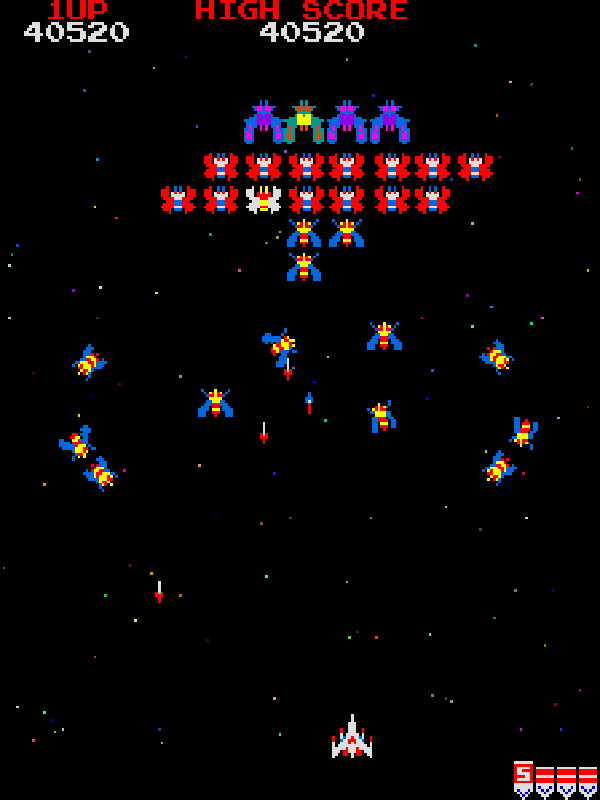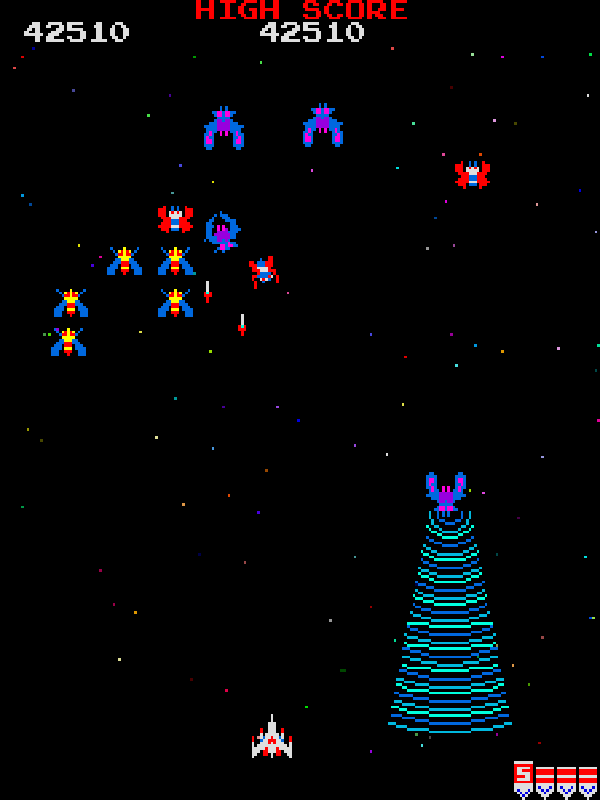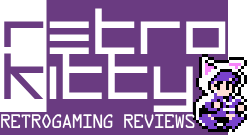Retrogaming Reviews — Latest · Alphabetical · Score · Articles · Site News · Random
Platforms — Arcade · Game Boy · Genesis · NES · PS1 · PSP · Saturn · SNES · TG-16
Arcade · Fixed Shooter · 1981

Evolution of the Fixed Shooter
First there was Space Invaders, created by Taito in 1978: the first widely-popular arcade game,[1] and the very first fixed shooter — a subgenre of shooter that only allows movement on one axis. While staggeringly popular for its time, it feels very dated and rather clunky today.
Namco stepped up to the plate next, and a mere one year after Space Invaders, Galaxian improved the formula in countless ways — full-colour graphics, real differences between the enemy types, alien ships that swoop down and dive-bomb the player. Again, it still hasn’t aged as well and feels stiff and slow, but it was leaps and bounds ahead of Space Invaders.
Two years later, Namco perfected the formuala with Galaga, a fixed shooter released in 1981 — the year of my birth, no less — taking everything that made Galaxian good and turning the dial up to 11.
Friends, Romans, countrymen, lend me your ears: today I’m going to tell you what makes Galaga an all-time classic, an arcade game that still holds its own 44 years after it first graced the sticky floors of the video arcades.
I May Be Biased
I may be a little biased here, because this is one of my favourite arcade games of all time — up there with the likes of Bubble Bobble and Gauntlet II — but I honestly think if this game was released today as a little indie title, gamers would love it. But okay, okay. Let me go into the facts.
Galaga is a fixed shooter, in the vein of the aforementioned Space Invaders and Galaxian — you can move your ship from side-to-side, and shoot vertically at the swarm of alien ships above. Your goal, as with the other games, is to destroy all of the aliens present on the screen before they bomb you to death, and anything — a single bomb, or even colliding with an alien ship — will spell your doom.
The gameplay differs, though, in how the enemies appear — rather than a fixed wave, the enemies appear in groups, swooping in and dive-bombing from the sides and top of the screen before taking their formation above, followed by the next group, and so on. These patterns and movements are always fixed, allowing room for a skilled player to memorize their patterns and eliminate much or all of the swarm before they’re even able to settle into a formation.
 The enemies have more interesting and dynamic attack patterns than those in Galaxian — after taking formation, they’ll dive-bomb down either alone, in formation, or separately but at the same time as others, dodging and weaving around before disappearing off the side or bottom of the screen, only to shortly thereafter rejoin formation at the top. This alone is only a minor improvement over its predecessor, if it wasn’t for the special ability of the green/blue ships at the top.
The enemies have more interesting and dynamic attack patterns than those in Galaxian — after taking formation, they’ll dive-bomb down either alone, in formation, or separately but at the same time as others, dodging and weaving around before disappearing off the side or bottom of the screen, only to shortly thereafter rejoin formation at the top. This alone is only a minor improvement over its predecessor, if it wasn’t for the special ability of the green/blue ships at the top.
These guys — they’re green by default, but turn blue when shot once, requiring an extra shot to destroy — will sometimes attempt to deploy a tractor beam. If your ship gets caught in the beam, you’ll be claimed, losing a life and having your ship turn red, joining the alien forces. However…
Your captured red ship will dive-bomb along with one of the green/blue aliens, and if you destroy the accompanying alien, your ship turns white again and falls down the screen. Catching it with your own allows you to now control a double-ship, doubling your firepower! This makes it more of a risk/reward strategy, where sometimes intentionally getting caught can be worthwhile.
And Yet, There’s More
That’s right, I’m not done yet. :3
I could talk about how you’re able to fire two shots at once (each available shot resetting when it either hits an enemy or goes off-screen), allowing for much more frantic action, or how there’s interim stages between some of the regular waves called Challenging Stages, where enemies fly in and out of the arena in a fixed pattern, the game giving bonus points for how many you managed to destroy.
I could talk about the game’s audio — fairly simple, as one would expect from the time, but with an iconic and memorable game-start jingle, as well as a pleasing variety of beeps and bwoops as you fight the varied hordes of alien ships. The sounds just fit the game’s aesthetics perfectly, blending right in with the colourful, iconic arcade graphics.
I could talk about the secret bonus points for tricky actions such as defeating enemies in the exact order they appear on-screen, or even for destroying multiple enemies with one shot, which adds a heap of replay value and skill expression into a game that’s geared around competing for the highest possible score.
But I think I’ve rambled enough now, and if I’ve not yet convinced you that Galaga is one of the all-time arcade greats, with gameplay that still feels crisp and satisfying today, then nothing else will.
The Verdict

Footnotes
[1] Not the first arcade game ever, that honour goes to Computer Space.Discussion
If your comment doesn't show up right away, don't worry! Sometimes they can be delayed, but it'll appear soon.








